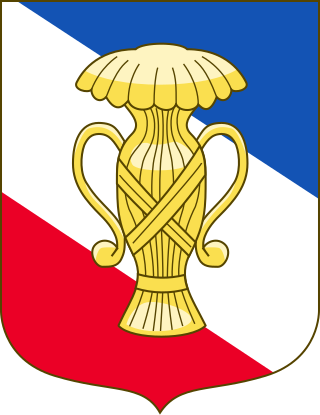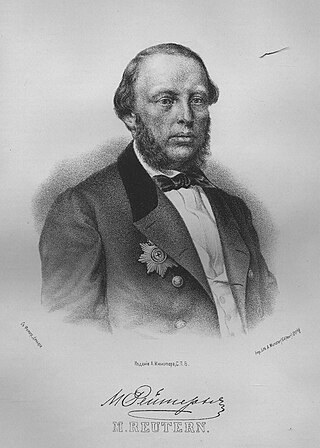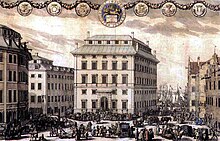
The history of Sweden can be traced back to the melting of the Northern Polar Ice Caps. From as early as 12000 BC, humans have inhabited this area. Throughout the Stone Age, between 8000 BC and 6000 BC, early inhabitants used stone-crafting methods to make tools and weapons for hunting, gathering and fishing as means of survival. Written sources about Sweden before AD 1000 are rare and short, usually written by outsiders. It was not until the 14th century that longer historical texts were produced in Sweden. It is therefore usually accepted that Swedish recorded history, in contrast with pre-history, starts around the 11th century, when sources are common enough that they can be contrasted with each other.

Adolf Frederick, or Adolph Frederick was King of Sweden from 1751 until his death in 1771. He was the son of Christian August of Holstein-Gottorp, Prince of Eutin, and Albertina Frederica of Baden-Durlach. He was an uncle of Catherine the Great and husband to Louisa Ulrika of Prussia.

Frederick I was King of Sweden from 1720 until his death, having been prince consort of Sweden from 1718 to 1720, and was also Landgrave of Hesse-Kassel from 1730. He ascended the throne following the death of his brother-in-law absolutist Charles XII in the Great Northern War, and the abdication of his wife, Charles's sister and successor Ulrika Eleonora, after she had to relinquish most powers to the Riksdag of the Estates and thus chose to abdicate. His powerless reign and lack of legitimate heirs of his own saw his family's elimination from the line of succession after the parliamentary government dominated by pro-revanchist Hat Party politicians ventured into a war with Russia, which ended in defeat and the Russian tsarina Elizabeth getting Adolf Frederick of Holstein-Gottorp instated following the death of the king. Whilst being the only Swedish monarch called Frederick, he was Frederick I of Hesse-Kassel and thus Frederick I also of Sweden, though other Swedish monarchs with non-repeating names have not been given numerals.

Charles XI or Carl was King of Sweden from 1660 until his death, in a period of Swedish history known as the Swedish Empire (1611–1721).

The monarchy of Sweden is centered on the monarchical head of state of Sweden, by law a constitutional and hereditary monarchy and with a parliamentary system. There have been kings in what now is the Kingdom of Sweden for more than a millennium. Originally an elective monarchy, it became a hereditary monarchy in the 16th century during the reign of Gustav Vasa, though virtually all monarchs before that belonged to a limited and small number of families which are considered to be the royal dynasties of Sweden.

The House of Vasa or Wasa was an early modern royal house founded in 1523 in Sweden. Its members ruled the Kingdom of Sweden from 1523 to 1654 and the Polish–Lithuanian Commonwealth from 1587 to 1668. Its agnatic line became extinct with the death of King John II Casimir of Poland in 1672.

The period following the accession of Oscar II to the throne of Sweden in 1872 was marked by political conflict. The Lantmanna Party, representing peasant proprietors, dominated the Lower House of parliament, and demanded tax reductions and reforms of the system of military service. The Upper House opposed these positions. A compromise was reached in 1884 with reduction in land taxes and increased periods of military service, processes that continued in later years.

Tre Kronor was a castle located in Stockholm, Sweden, on the site where Stockholm Palace is today. It is believed to have been a citadel that Birger Jarl built into a royal castle in the middle of the 13th century. The name "Tre Kronor" is believed to have been given to the castle during the reign of King Magnus IV in the middle of the 14th century.

Absolute monarchy in France slowly emerged in the 16th century and became firmly established during the 17th century. Absolute monarchy is a variation of the governmental form of monarchy in which the monarch holds supreme authority and where that authority is not restricted by any written laws, legislature, or customs. In France, Louis XIV was the most famous exemplar of absolute monarchy, with his court central to French political and cultural life during his reign. It ended in May 1789, when widespread social distress led to the convocation of the Estates-General, which was converted into a National Assembly in June. The Assembly passed a series of radical measures, including the abolition of feudalism, state control of the Catholic Church and extending the right to vote.
Riksrådet or Rigsrådet is the name of the councils of the Scandinavian countries that ruled the countries together with the kings from late Middle Ages to the 17th century. Norway had a Council of the Realm that was de facto abolished by the Danish-Norwegian king in 1536–1537. In Sweden the parallel Council gradually came under the influence of the king during the 17th century.
In the Great Reduction of 1680, by which the ancient landed nobility lost its power base, the Swedish Crown recaptured lands earlier granted to the nobility. Reductions in Sweden and its dominions were the return to the Crown of fiefs that had been granted to the Swedish nobility. Several reductions are recorded, from the 13th century until this final one of 1680.

Baron Johan August Gripenstedt was a Swedish businessman and politician. During his political career, Gripenstedt was a member of the Swedish Estates Assembly from 1840 to 1848, Minister without Portfolio from 1848 to 1856, Minister for Finance from 1856 to 1866, and Member of Parliament from 1867 to 1873. He is best known for his ten years tenure as Minister for Finance, during which he introduced many liberal economic reforms and fought for issues such as free trade and state owned railways.

The early modern era of Polish history follows the Late Middle Ages. Historians use the term early modern to refer to the period beginning in approximately 1500 AD and lasting until around 1800.

The Swedish Empire was the period in Swedish history spanning much of the 17th and early 18th centuries during which the country became a European great power that exercised territorial control over much of the Baltic region. The beginning of the period is usually taken as the reign of Gustavus Adolphus, who ascended the throne in 1611, and its end as the loss of territories in 1721 following the Great Northern War.

Sven-Erik Österberg is a Swedish official and former social-democratic politician. He is the former Governor of Stockholm County from 1 February 2018 to 28 February 2023 and previously served as Governor of Norrbotten County from 1 October 2012 to 31 January 2018. Österberg was Minister for Financial Markets from 2004 to 2006.
From 1611 to 1721, Sweden was a European great power, becoming a dominant faction in the quest for control of the Baltic Sea and a formidable military power. During this period, known as Stormaktstiden, the Swedish Empire held a territory more than twice the size of its modern borders and one of the most successful military forces at the time, proving itself on numerous occasions on battlefields such as Wallhof, Narva, and Düna. The military of the Swedish empire is commonly recognized only as the Caroleans, which were in fact not in service until the late 17th century under Charles XI XI and his successor. The Swedish Empire and its modern military force was founded by Gustavus Adolphus, who inherited the throne in 1611 at age 17. He immediately reformed the common European military based on mercenaries to a professional national army. However, before completing his vision of conquering the Holy Roman Empire, the warrior king was killed in action in 1632. His daughter and successor did little to improve Sweden's military position and abdicated early, providing the Swedish Empire with a more warlike ruler. Charles X Gustav was only king for 5 years, but conquered large amounts of territory that still belong to Sweden today. His son Karl XI would further strengthen the army by introducing the Caroleans, which were also used by Karl XII in the Great Northern War.

Estonia under Swedish rule (1561–1710) signifies the period of time when large parts of the country, and after 1645, entire present-day Estonia, were under Swedish rule. In the wake of the breakup of the State of the Teutonic Order, the Baltic German local nobility in the areas of Harrien (Harjumaa) and Wierland (Virumaa), as well as the city of Reval (Tallinn) in June 1561 asked for and were granted protection by the Swedish king Eric XIV, leading to Swedish involvement in the Livonian War. At the conclusion of hostilities in 1583, Sweden was in control of the northern parts of modern Estonia and Dagö ; the Duchy of Estonia was created from this territory. Following renewed wars between Poland and Sweden, the southern parts of present-day Estonia were incorporated into Sweden by the Treaty of Altmark in 1629. Sweden also conquered the island of Ösel (Saaremaa) from Denmark, and were thus in control of all of present-day Estonia.

In Swedish and Finnish history, Finland under Swedish rule is the historical period when the bulk of the area that later came to constitute Finland was an integral part of Sweden. The starting point of Swedish rule is uncertain and controversial. Historical evidence of the establishment of Swedish rule in Finland exists from the late 13th century onwards.
Events from the year 1668 in Sweden

Michael Graf von Reutern was a Baltic German statesman and the Finance Minister of the Russian Empire from 1862 to 1878.
















